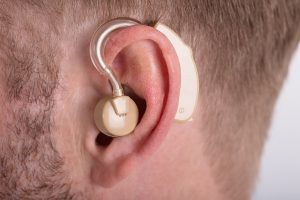When we age, we often loose our hearing, but hearing loss may come from aldosterone deficiency as well. Dr. Richard Lippman has been researching hearing loss and noted that there is a close relationship in many older patients with aldosterone deficiency of the adrenal glands. His next step was to replace the missing aldosterone and see whether this would improve hearing. When patients took 125 microgram capsules several times per day, they experienced temporary relief from their hearing loss. Dr. Lippman investigated this and found that it was the short half-life of aldosterone that was the problem. Once the body metabolized the drug, it left the body. As a result the hearing loss improvement did not last.
Lippman protocol
In 2011 he developed the Lippman protocol where patients would take regular aldosterone for several days and then synthetic aldosterone (Florinef®) for several days. In 2014 Dr. Lippman noted that his protocol needed improvement by using time-release aldosterone eardrops. This approach relieved hearing loss and improved word recognition. In addition it also reduced too frequent bathroom visits, an effect of aldosterone on bladder function.
Other effects of aldosterone deficiency
Low aldosterone levels in a person are generally a sign of aging. Aging changes the circadian rhythm and with it the sleeping depth. The ACTH/cortisol response increases, but aldosterone production of the adrenal glands decreases. This can cause dizziness, low blood pressure, particularly on rising in the morning. Some people experience dehydration and salt craving. There is an imbalance in the potassium/sodium ratio, which leads to energy loss in the 15,000 hair cells of the inner ear. When a person looses hearing, the hair cells are still there, but they do not have the energy to function normally due to aldosterone loss.
Further development of aldosterone application
As the tablet form of aldosterone was wearing off too fast for a lot of patients, the development of a gradual -release form of aldosterone was the next development. It is called aldosterone sustained-release ear spray (Aldo® spray). It delivers 125 micrograms of aldosterone in oil into each ear canal. But the costs are somewhat prohibitive (90.00 USD per month). Many people gain 30 to 40 decibels of hearing with this protocol. But when you stop treatment, the results fade and hearing loss and tinnitus reoccur.
Conclusion
Hearing loss is common and typically part of aging. For persons who worked in industrial work situations, hearing loss is frequently due to exposure to loud noises and not wearing hearing protection. Most cases are also due to age. As I mentioned earlier the age-related cases are mostly due to aldosterone deficiency. Often there is also an association to chronic stress, which undermines aldosterone production of the adrenal glands. In these cases most of the adrenal function is necessary for cortisol production to help the person fight stress.
Conventional versus non-conventional restoration of hearing
Conventional medicine is just interested in relieving the patient’s symptoms (hearing loss). A person with hearing loss is therefore referred to a hearing clinic, where he/she is assessed and will receive a hearing aid. However, this newer research shows that many people with hearing loss may have a deficiency of aldosterone. Blood tests or 24- hour urine tests can confirm this. If the test indicates aldosterone deficiency, it would be sensible to consider aldosterone supplementation. It will improve the condition or avoid the need for a hearing aid.







